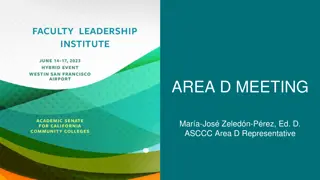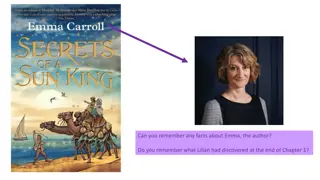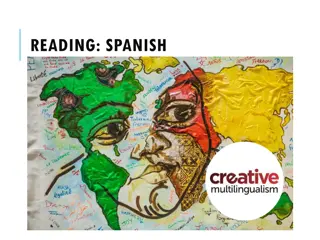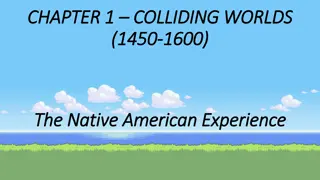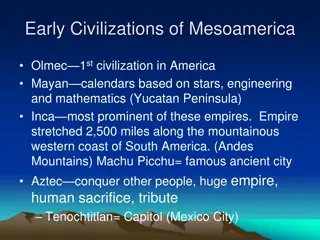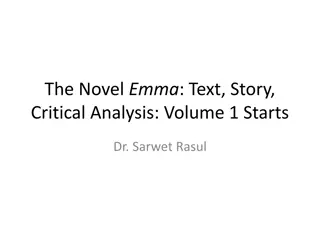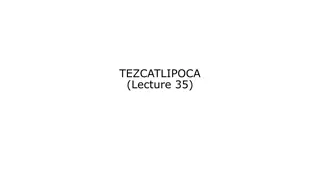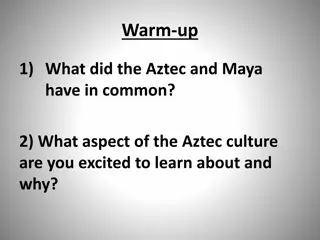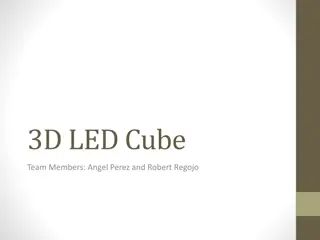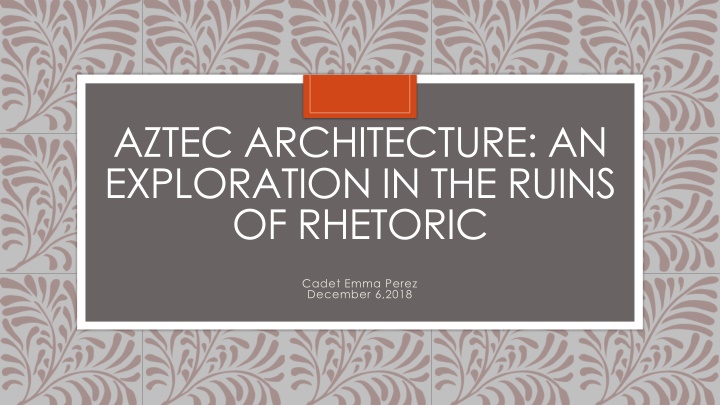
Exploring Aztec Architecture and Rhetoric Through Ancient Ruins
Delve into the world of Aztec architecture and rhetoric as seen in the ancient ruins, showcasing how the Aztecs used art and structures to communicate power, religion, and government. Learn about the Aztec civilization, their polytheistic beliefs, and the significance of pyramids in their society.
Uploaded on | 0 Views
Download Presentation

Please find below an Image/Link to download the presentation.
The content on the website is provided AS IS for your information and personal use only. It may not be sold, licensed, or shared on other websites without obtaining consent from the author. If you encounter any issues during the download, it is possible that the publisher has removed the file from their server.
You are allowed to download the files provided on this website for personal or commercial use, subject to the condition that they are used lawfully. All files are the property of their respective owners.
The content on the website is provided AS IS for your information and personal use only. It may not be sold, licensed, or shared on other websites without obtaining consent from the author.
E N D
Presentation Transcript
AZTEC ARCHITECTURE: AN EXPLORATION IN THE RUINS OF RHETORIC Cadet Emma Perez December 6,2018
Unwritten forms of Rhetoric Rhetoric: a form of effective symbolic expression used to adapt ideas to an audience by means of resources and symbols (Herrick)
ARCHITECTURE AS RHETORIC
Architecture as Rhetoric Communication and rhetoric are fundamental facets of architecture Primarily focuses on function and meaning behind the constructed form because it encourages its perceiver to understand the meaning behind the design of the building
Who were the Aztecs? Flourished in the Mesoamerican Valley in Mexico 1100 CE -1565 CE Polytheistic religion Theocratic government Government was conducted in religious settings Spoke Nahuatl Was found that when the Spanish conquered the empire, erased all written record Writing was not prominent in their society
THE MEXICAS USE OF ART AS RHETORIC Utilized art to induce the ideas of strength within religion and government Emperors wanted to show superiority over past and future rulers Instructed artists to build larger structures and beautiful art forms Wanted them depict the out-of-worldly role their gods had in the empire Architecture was among the strongest influencer The Olmec Mask found in the ruins of Templo Mayor
Pyramids stood in the center of major cities Intended to make individuals feel insignificant & small On top each pyramid a temple was placed Temples were designated to gods Geometric and sweeping lines represented power of god and government By practicing government in religious setting, nobility generated power over the theocratic society by portraying themselves as divine rulers with power inherited by the gods
Templo Mayor Largest and most important pyramid Stood in Tenochtitlan (empire s capital) Tenochtitlan was the center of the empire The design reflects the Mexica cosmos The cosmos were structured around the navel of the universe Navel of the universe = Axis Mundi Axis mundi was the idea that the universe consisted of three layers: earth, sky, and underworld. Temple was strategically placed to be where the three layers met Made temple significant because of the beliefs that it connects the layers of universe
Gods of Templo Mayor Empire relied heavily on the cardinal directions: north, south, east, and west Each direction was associated with various deities, birds, and colors As the center of the universe, was believed the directions radiated from Templo Mayor Templo Mayor had two temples on the top of it for two different gods Huitzilopochtli and Tlaloc Temples were on a north-south axis and painted different colors
Huitzilopochtli vs Tlaloc Tlaloc Huitzilopochtli Southern temple God of war, fire, and the cosmos Also patron god of the Aztecs Temple was painted red to symbolize war and dry season and the winter solstice Human skulls lined the walls Temple was designed with sharp, defined lines Lines were to represent war and bloodshed Northern temple God of rain and Earth s fertility Temple was painted with blue and white stripes to symbolize summer solstice and wet season Temple was designed with sweeping, defined lines to mimic ripples in water Conch shells and sea creatures were engraved into the walls
Together, the gods represented the idea of atltlachinolli Atltlachinolli = burnt water Huitzilopochtli & Tlaloc Symbol of warfare and peace Together the gods encompassed the natural and social balances of the universe Tlaloc marked times of rain Huitzilopochtli scorched the earth with the sun and war The duo symbolized the circle of life and fertility within the Aztec depiction of Atltlachinolli empire and represented the symbolic heart of the universe by being the deities of Templo Mayor
Huitzilopochtli & Tlaloc as rhetorical vices Huitzilopochtli and Tlaloc s temples were rhetorical vices from the rulers to the public Temples were viewed as prominent sources of government and religion Use of blue and red and design were intended to bring the idea that war and peace coincide Tlaloc s temple was built with more rounded and delicate looking structures than Huitzilopochtli s temple which had very sharp, distinct lines

